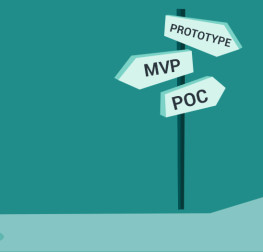Here’s the Enterprise Mobile Strategy for 2020and Beyond
Many enterprises are today stuck in a complex IT ecosystem which needs mobility to leverage latest advancements. Mobile led initiatives are transforming every business sphere:

While some of these mobility initiatives are strategically planned, some others, not so well. Most of the mobile application development projects are based on competitor offerings and immediate business needs. The lack of foresight and inability to form a holistic enterprise mobile strategy prevents organizations from harnessing good returns on their mobile-related investments. This article will help you align all your mobility initiatives with the proper mobile strategy planning and develop a framework which keeps all projects on track with minimal course correction.
6 strategic steps for the success of your mobile initiatives
1) Bring all stakeholders to a common ground
It is often seen that different IT stakeholders and strategic decision makers have different opinions, expectations, and agenda when it comes to leveraging mobile. For example, a CMO might not show a keen interest in developing enterprise mobile apps for the internal communications team. Further, the IT team is often tasked to look out for point solutions to meet immediate needs. This approach creates a complex ecosystem of applications and solutions which rarely works in sync or provides any value to the organization.
It is important for an enterprise to take a step back and redefine its mobile strategy to remove these inefficiencies arising from the fragmentation of IT. As discussed, the first step is to compile and map all immediate and future requirements with their respective end user/beneficiary groups. The above initiative will play an important role in providing clarity for the following mobile application development stages:
- Goal Setting, business case identification: Identify and prioritize your enterprise mobility goals vis-a-vis your business goals. This will help you in better alignment of mobility strategy with your core business objectives.
- Drawing the enterprise mobile roadmap: Create a roadmap with the team driving the mobility initiative. This shall help you create realistic deadlines while bringing everyone on the same page.
- MADP platform evaluation and selection: It’s important to choose an MADP platform that not only meets business needs but also allows developers to create user-friendly solutions with ease.
- Solution architecture, design, development, and deployment: Most businesses often lose track of their project during these critical stages. Organizations need to adopt latest Agile frameworks for better visibility and control over these processes.
- Quality Assurance: Choose tools and methodologies to support quicker development without compromising on the quality. Most of this can be achieved with Automated testing.
- API management and modernization: Enterprises have developed a complex ecosystem of APIs that interact with each other. There is a need to manage these APIs in a secure and scalable environment.
- Mobile UX improvement: A lot of enterprise resources are never utilized as complex workflows hinder their access to the intended users. Improvements in UX can remove such inefficiencies.
- Governance, Security, and Compliance: Develop policies to create a perfect balance between connectivity, security, and productivity needs of your organization.
2) Identify mobile-readiness and create a transition plan
Most organizations have a core business group which frequently interacts with partners and top executives. Somehow, their needs for mobility are well addressed as they have more freedom to experiment and adopt third party products. At the same time, internal employees and field workers continue to perform on legacy platforms. This creates pronounced differences in the way different groups in an organization collaborate. It also creates visible bottlenecks in the information flow and availability.
While there is a need to create a common mobile ready enterprise suite, it would not be prudent to force all your teams to suddenly jump onto this new system for routine office and field work. There could be many challenges:
- Data Migration: Data migration can be a headache for the IT team and there could be compatibility issues
- Reluctance to change: generally, people in an organization develop a working culture which is not conducive to adoption of new solutions
- BYOD management: there could be security and authorization related concerns
During the mobile strategy planning, decision-makers need to create a transition plan for any mobile initiative which affects the entire organization. It is advisable to avoid any overlap with a business-critical initiative. A roadmap describing phased release can be drawn after taking inputs from all the teams.
3) Gauge and improve user experience (UX)

There are ‘n’ number of solutions to most problems – yet only certain solutions gain acceptance. UX is a critical factor in deciding this acceptance. If you are planning to solve a certain problem with a mobile solution, it must simplify things for the end-user. For example, improvements in the UX can not only make mobile a preferred medium for catalog viewing but also reduce shopping cart abandonments. Hence, UX is a key consideration for designing the functionalities and behavior of a customer App.
Further, a myriad of enterprise applications remains underutilized due to the similar UX deficiencies. As a business decision maker, you must ensure that all technology specific decisions – starting from the ‘selection between a native and a hybrid app’ to the selection of ‘data access points’ and a ‘content delivery network’ – are taken with UX as a top priority.
Build a Strong Foundation
4) Work with Agile & DevOps communities
While creating an enterprise mobile strategy you will have to select a working methodology and tools that can support high speed development and collaboration among the developers. Agile and DevOps frameworks have become a default choice for companies that develop mobile applications with higher transparency, speed, and quality. DevOps will help you gain end-to-end visibility and access to your application designs, code, test scripts and other related documents. It will help you easily identify all the APIs and services used in the development.
Further, it is most suited for enterprise projects which are expected to run over a long frame of time with the involvement of multiple teams and vendors. Devops ensures that with continuous integration the code delivered by one team is reusable and can be integrated with a code delivered by another team. Also, DevOps will automate a lot of functional tests, ensuring that quality is not compromised for quicker deliveries. Make sure your software vendor is employing a DevOps framework to provide:
- Continuous integration and continuous delivery
- Automated testing and monitoring
- Mobile app delivery
5) Setup Governance, Security, and Compliance policies
While high-profile data breaches involving advanced malware, APTs, and phishing scams hog most of the news headlines, the fact is that lost or stolen enterprise mobile devices (including laptops and tablets) continue to be the leading cause of data breaches. According to a news report “25.3 percent of data breaches that have occurred since 2006 were due to malicious actors getting their hands on a corporate mobile device”. To make sure that mobile doesn’t become a liability, your enterprise mobile strategy should clearly define a strong governance process. This will involve standardization of protocols for:
- Mobile application development and deployment processes
- Mobile sourcing vendor and vendor management
- Mobile Device Management (password, encryption, data security, remote wipe, lockouts etc)
- Mobile Application Management
- Provisioning and de-provisioning of devices
- Integration of MDM Solution with Enterprise Systems
6) Create a watch group to gauge disruptive trends

During the mobile strategy planning, you should also evaluate its associated technology trends. The general perception of mobility has changed drastically in the last two decades. Facebook recently announced its plan to eliminate smartphones from the consumer space. Discarding any associated trends in the technology space without any proper evaluation can prove to be costly for enterprises.
Enterprises must keep track of the latest developments in Blockchain, IoT, Conversational Apps, Artificial Intelligence, and immersive technologies like AR & VR. To meet these objectives, enterprises often create R&D labs for testing and validation of new ideas with PoCs.
Further, organizations need to promote ideas and incentivize those who come forward and take a lead in such initiatives. These technology initiatives may or may not align with your core mobility efforts, but some of them might carry the potential to transform your organization.
Create superfast PoCs, Prototypes & MVPs
Credencys Solutions Inc is a leading mobile applications development company and solutions provider. You can contact us for mobile strategy consulting and developing mobile apps for multiple platforms. Subscribe to our blogs for getting similar articles on management, strategy, leadership and more.











Tags: